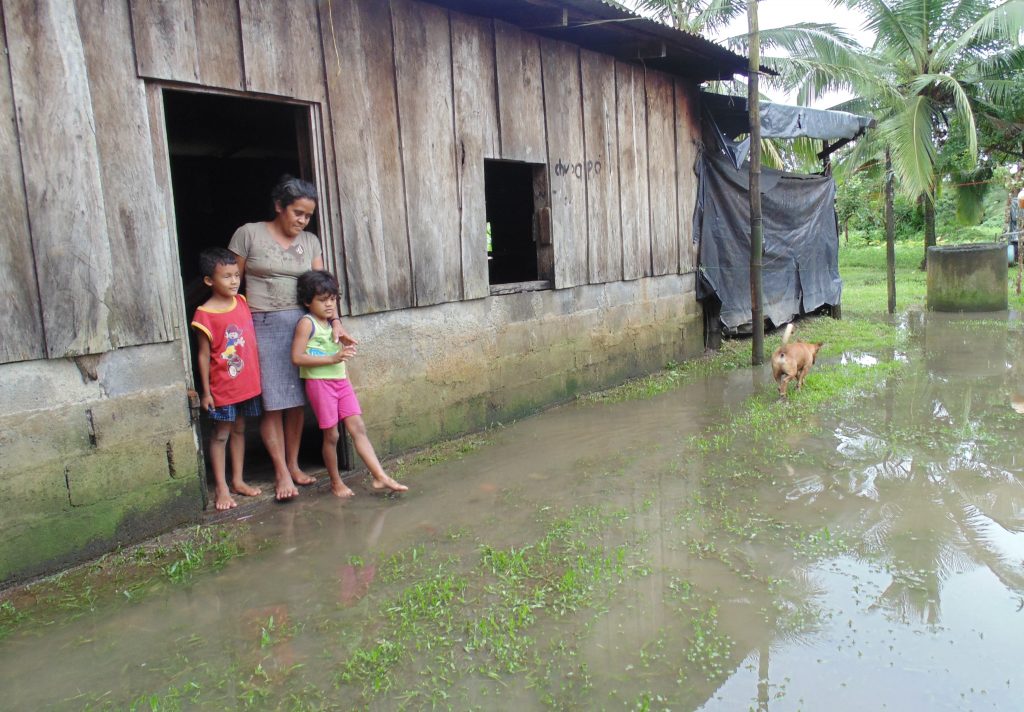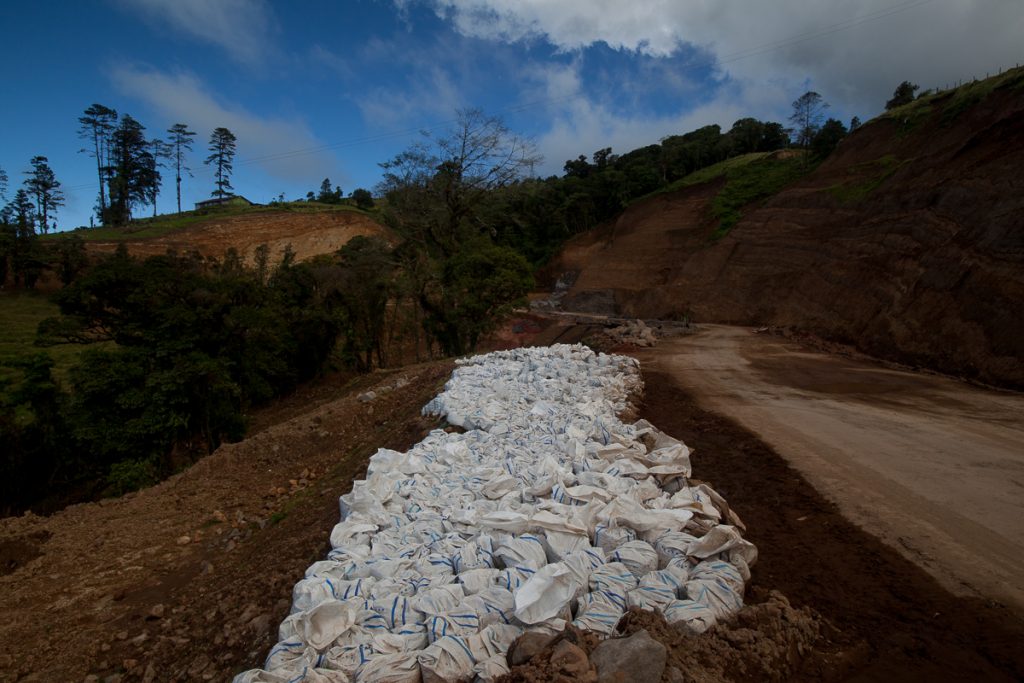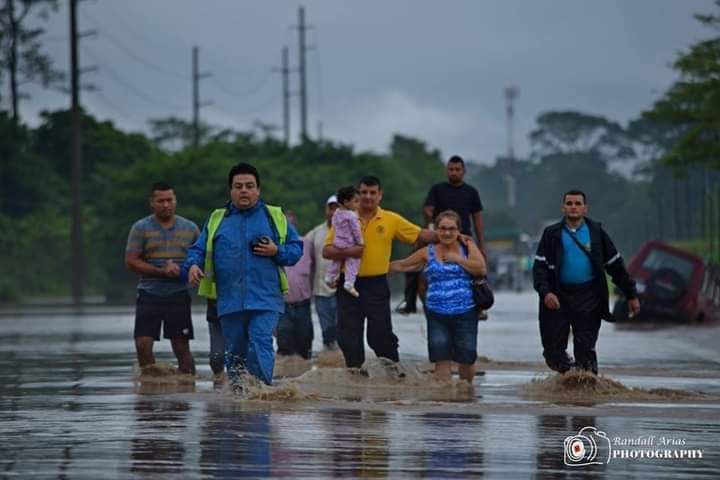Alfonso Gatgens prepared this longform piece on emergencies in Sarapiquí without knowing that the greatest emergency in more than a decade was headed for the canton he calls home. Today, we share his analysis of the efforts that have been taking place to create an early alert system in Sarapiquí; tomorrow, we’ll share his reflection on what happened over the past week, and how it put that system to the test.
When the two major tributaries of the Sarapiquí River basin—the Chirripó Norte River (better known as Río Sucio) and Puerto Viejo River—run high, the Sarapiquí, increasing its flow, cause floods that affect communities downstream, including some close to the Costa Rican-Nicaraguan border.
Floods are common in the canton of Sarapiquí when it rains, especially in the months of December and January, and sometimes in the middle of the year, in June and July.
These floods, or “llenas” as they are popularly known, are caused by the flooding of the rivers that make up the Sarapiquí basin.
Cristian Cordero, a member of the Red Cross and the canton’s Municipal Emergency Commission, told El Colectivo 506 in June that the floods take place to a greater or lesser degree each year, with the floods of 1970 and 2005 as the most devastating on record.

“An example of how big this last flood was in 2005 was that the waters of the Sarapiquí River reached the soccer field in Puerto Viejo,” Cordero recalls. “The water covered half of the National Bank building, putting the ATM out of commission. In addition to flooded towns, closed streets and highways, entire families were left with only what they were wearing. They lost everything.”
Another important event for the canton was the one that occurred after the Cinchona earthquake in 2009: the resulting avalanche went down the Sarapiquí River, leaving millions of dollars in environmental impact and losses in agriculture and tourism.
What happened during the Cinchona quake was worrying not only because of the unprecedented tragedy, but also because it is an event that could be repeated in the area, according to Douglas Salgado, of the National Emergency Commission’s risk investigation unit.
“The canton of Sarapiquí is highly sensitive not only to floods, but also to the issue of earthquakes and natural threats from volcanic events,” he told El Colectivo 506 via Zoom. “What will happen now with Sarapiquí if we do not reverse climate change — which is already there—is that this will increase droughts and possibly cold fronts.”

A new early warning system
The avalanche brought by the Cinchona earthquake carried something else with it: a new possibility for a canton where residents had become accustomed to regular flooding.
Jackeline Araya, who has participated in the Sarapiquí Municipal Emergency Committee since its creation, explained that when the earthquake occurred, leaders were working at the regional level on a pilot of early warning systems (SAT) for all of Central America. After the earthquake, implementation of the pilot began in Sarapiquí, with the participation of the CNE, the Municipality of Sarapiquí and other public institutions, private companies, and the population at large.
As in the SAT Upalaproject, the SAT requires equipment—but even more importantly, human infrastructure. Therefore, the project began with the formation of 20 committees in different areas of the canton’s 5 districts, Jackeline says. From 2010 to 2012, 200 people were trained as representatives of the committees.
Parallel to this process, the equipment was set up. This involved the placement of communication radios in strategic locations in the Sarapiquí basin—the homes of members of the Community Emergency Commissions, and in public institutions—with direct communication with the CNE. From these radios, committee members provide weather reports twice a day to the CNE, with additional reporting during extreme situations such as when “heads of water fall and could affect populations downstream,” says Vanessa Rodríguez, Vice Mayor of Sarapiquí and coordinator of the Municipal Emergency Commission.
In addition to the radios, three sirens were placed in La Virgen, Chilamate and Puerto Viejo, near the Sarapiquí River, to alert the residents of possible floods so they can organize themselves the Communal Emergency Commissions. Residents are to leave their houses and head to shelters in schools or community halls until the waters subside and they can return to their homes, says Rodríguez.
The system has been tested several times thanks to drills carried out within the framework of the SAT Sarapiquí project. National University geologist Rafael Oreamuno helped direct simulations of a flood caused due to simultaneous flooding of the Sucio, Puerto Viejo, Sarapiquí, Volcán, and San Juan Rivers.
Two drills were carried out simultaneously in the communities of Naranjales and Caño San José to assess the technical and practical capacity of the SAT,with international observers, adds Jackeline Araya.

The Sarapiquí Early Warning System was then presented to international entities so that it could be replicated, not only in other cantons of Costa Rica, but also in countries that want to take the example of Sarapiquí and adapt it to their realities.
In May 2013, Sarapiquí’s SAT program was presented to the main panel of the Global Platform of the World of Disasters in Geneva, Switzerland, with a delegation from the CNE, IMN, and other entities. Presenters sought to demonstrate that the SAT could be applied in various communities and countries, but also to obtain funds to replicate the SAT Sarapiquí in Pacific coast communities such as Partia, and to buy a satellite for climate observation in the Sarapiquí River Basin.
After the presentation, the participating countries approved the funds for the SAT system in Parrita and the satellite for Sarapiquí, Araya says.
For Douglas Salgado of the National Emergency Commission, one sign of the project’s impact occurred during Hurricane Otto in 2016.
He recalls that during the passage of that hurricane, Sarapiquí was one of the cantons that reacted most effectively to the yellow and red alerts put in place for the area.
“The response was very good,” Douglas says. “The institutions were able to carry out and fulfill their tasks during Hurricane Otto, and then we had the experience again in Tropical Storm Nate in 2017. Sarapiquí behaved in an outstanding way. The response of the institutions was excellent, due to the experience that had already been gained in 2011 and 2012.”

A common challenge: maintenance and protection
Despite these achievements, those in charge of the system in Sarapiquí continue to face challenges to ensure its operation and efficiency. One of these is equipment maintenance. For Cristian Montero, current weaknesses have short term fixes: one is that two of the sirens placed near the river are not working due to a lack of batteries. The other is that some of the radios are working but are turned off, or are not being answered properly.
According to Vice Mayor Vanessa Rodriguez, these problems are being addressed: as for the sirens, a new diagnosis of the state of the sirens was sent in May to the National Emergency Commission. The Municipal Emergency Committee has identified the radios that are not being answered and is in the process of relocating them—that is, they are going to be moved to places where there are people committed to keeping them on and answering them.
Douglas Salgado, from the National Commission, says that challenges at the municipal level are very common in Costa Rica when it comes to the designation and execution of resources for emergency response. Douglas explains that Law 848 obliges municipalities to dedicate part of their budget to risk management, but that it is common for municipalities to fall short.
“Regarding risk management, they don’t schedule it, they don’t budget for it,” he says, speaking generally about municipal governments. “The law empowers the municipality to budget resources for risk management, which is a very broad umbrella. It goes from equipment to community training.”
That law means that the municipality is responsible for ensuring that sirens and radios are active and working, says Douglas.
“The Comptroller General of the Republic called the Sarapiquí Municipality to attention in 2017 with a document indicating that the municipality has to invest in risk management,” says Douglas.

He adds that in 2019, when he had to lead the participatory planning workshops where communities and institutions created their work plan for improvements in Sarapiquí, he pointed out the importance of these investments.
“We found that one of the weaknesses is the local government of Sarapiquí’s support for communities, especially community [emergency] committees,” he says. “They basically depend on the CNE for education and training, which has generated a very strong codependency. The municipality should be [responsible for] supporting communities on these issues.”
Vanessa Rodríguez explains that the municipality did budget resources for training on these issues for 2020-2021, but those funds had to be redirected due to the pandemic. Resources are once again contemplated for training in 2022, and will be directed to the Community Emergency Committees, as well as to the members and volunteers of the Municipal Emergency Committee.
Another challenge has to do with maintaining that human infrastructure. Jackeline Araya says it’s getting harder and harder to get younger community members involved. For them, there must be economic retribution for ongoing communal work.
“For me, that makes it hard for a project like this to be sustainable over time,” says Jackeline.
However, she stresses that communities are also rallying around the main objective of safeguarding human life, and being more resilient in the face of emergencies.
Along the same lines, Cristian Cordero points out that there are currently eight communities in the canton that are requesting the creation of Community Emergency Commissions for the first time.
Yelena Mata Brenes, from the El Roble de La Virgen, says she likes the coordination that has occurred over the years between institutions and communities for the good of the canton. Her community got involved in the issue in 2015, when they got started by organizing a community emergency committee after a “llena” from the Sarapiquí River damaged the bridge that leads to El Roble.
“Since then we have been fighting for resources for that bridge that the CNE is going to finance for us,” Mata said. “I feel that it is an articulated, participatory work, where the result is that the communities are more organized. They are more informed regarding the early alerts.”
In 2019, the last training to date was carried out. Due to the pandemic, communities have not been able to receive further training.
“In that last training, those of us who are part of the community emergency committee could not go, but with alliances that we have made with other communities, we managed to get a colleague from another community to come and give us the training,” recalls Yarela. “We did a workshop here in my house and he passed on that knowledge to us. We made a rain gauge with a bottle of water. This way, we know exactly how much it has rained… I feel that the early warning system has helped the communities. The canton has faster response times because of the communication that is maintained between the different institutions involved. This has helped save lives.”
Civil society organizations in the area have also been involved in preparing to reduce threats caused by natural events. An example is the Association for the Protection of the Sarapiquí River Basin.

According to a spokesman for the group, Juan Amiguetti, Sarapiquí is more vulnerable to a disaster than in the past, due to the extraction of materials such as sand and stone in the upper parts of the river. This extraction occurs in communities such as Chilamate, La Virgen and San Miguel.
This affects the communities downstream, not only from the environmental and tourism perspective, but also in terms of vulnerability to natural events. Extraction is causing the Sarapiquí to overflow where it did not before, Juan says.
He recalls that in 2001, a plebiscite was held in the canton that resulted in a vote to declare the Sarapiquí River basin a Natural Historical Monument. This forced municipal representatives to present a bill to Costa Rica’s Legislative Assembly in order for the declaration to be implemented. However, the bill was not approved.
“Since Aprocsara was formed in 2017, we have been working on a bill to conserve the river and reduce thee extraction of materials: Bill #22524 for the sustainable development of the Sarapiquí River basin and the protection of its main channel,” Juan says.
The bill would prohibit extraction for 25 years.
“We already have the signature and commitment of 21 legislators. Through the initiative of citizens, it has already entered the Legislative Assembly. We are working to get more support and ensure its prompt approval,” Juan says.
The future of the SAT Sarapiquí
Cristian Cordero says that the SAT Sarapiquí is still working, despite the pandemic. Its managers, both on the Municipal Emergency Commission and at the community level, have had to adapt to technology to be in contact and carry out workshops and updates.
“During the pandemic, we are raising awareness in the communities so that they come together and integrate—making them understand that in the event of a natural disaster, we should not wait for things to fall from the sky. We have to start working,” says Cristian. “As a citizen, I can work together with my community in the first 34 to 36 hours while auxiliary aid comes, whether it be aid from an institution such as the CNE or aid from abroad.”
“With regard to the llenas, we’ve seen adaptability develop over time,” says Jackeline. There’s been synergy between the National Emergency Commission, the Municipal Commission, and the community committees. They’ve managed to make this system work for the long term. The SAT Sarapiquí can and must be replicated in other parts of the country, and in other areas—always understanding the different problems, depending on the threat and local realities.”

Tomorrow: the floods from July, 2021.





